
The Complete Guide to Growing Your Organic Facebook Reach
Former VP of Marketing @ Buffer
Nowadays, when I endeavor to check my Facebook statistics, I do so with the window open, birds singing, a pint of ice cream at my desk, and party jams playing on my jambox.
I must balance the bad news with some good.
Checking Facebook statistics has been bad news for a lot of us lately as we wrestle with declining numbers and shrinking reach. As the Facebook algorithm continues to change and adapt, we continue looking for answers. Why can’t we reach more fans with our updates? What kind of content should we be sharing?
What can we do about our declining Facebook reach?
The question comes up quite often, in the comments here on
Our posts on Facebook reach an average of 4.5 percent of our fans.
- Overall reach has been on a slow decline for the past several months.
- Twitter is far and away our top referral source to the blog. Facebook brings in little more than 1/3 the traffic that Twitter does.
Do these numbers sound familiar? Do yours look similar? We’re keen on finding the answers and experimenting with ways to reverse this trend and to get our Facebook content seen by more fans and followers. We imagine you’d like the same for your business. Here’s what we’ve come up with so far.
The problem with Facebook reach, explained in a single graphic
Facebook reach is on the decline for just about everyone. A study by Social@Ogilvy found that organic reach has declined to 6 percent, a drop of 49 percent from last October. In other words, if you don’t pay Facebook to boost your content through advertising, you can expect an average of six people to see your content for every 100 fans you have.
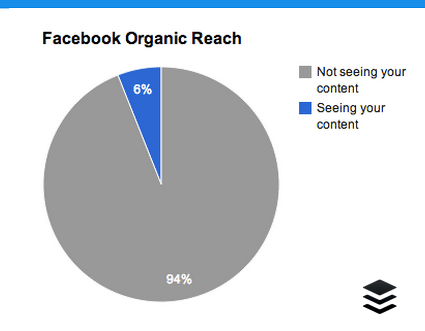
Facebook has its reasons for limiting organic reach, of course. The sheer volume of users, brands, and content on Facebook makes it such that the news feed could become a vastly overcrowded place without Facebook’s intervention. More than 18 million business pages are competing for space on Facebook.
There are other financial reasons, too. One of the quickest ways to boost your reach is by paying Facebook for advertising. The connection is not lost on Convince and Convert’s Jay Baer who put two-and-two together to come up with this mashup graphic of the declining Facebook reach and the rising Facebook stock price.
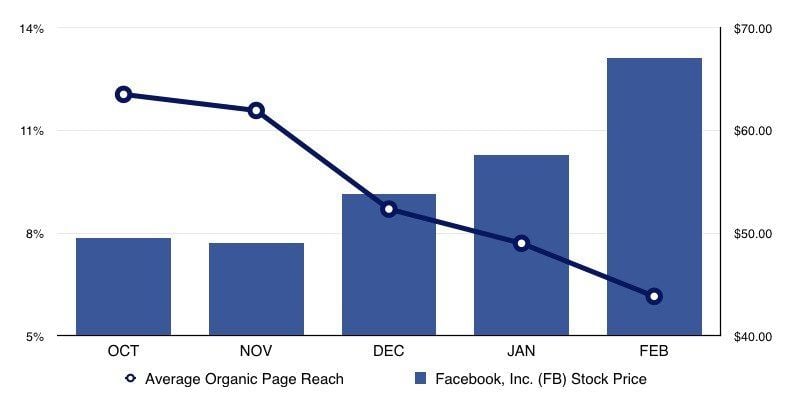
How Facebook calculates what shows up on your news feed
The short answer here is that no one knows exactly how Facebook determines what shows up or—more frustratingly for marketers—what doesn’t show up on a news feed.
What we do know is that the process is complicated. According to Facebook engineer Lars Backstrom, as many as 100,000 individual weights go into the model that produces a news feed.
So the solution to declining reach is not as simple as tweak this or fiddle with that.
There are a few elements of the algorithm that are public knowledge, including the following:
- Post types (e.g., photos vs. text vs. video) that receive the most interaction from a user
- Which posts a user hides or reports as spam
- A user’s interaction with Facebook ads
- The device and Internet speed of a user
In addition, the three pillars of EdgeRank, Facebook’s original news feed ranking system, remain part of the current news feed algorithm.
Affinity – This refers to your relationship with the user, how much he or she interacts with your page.
Weight – Facebook places priority based on post type, giving top priority to videos and photos.
Decay – How old is your post? The longer your post has been around, the less likely it will be to show up in news feeds.
Here is a snippet of an infographic by PostRocket that sums up how these EdgeRank factors work:
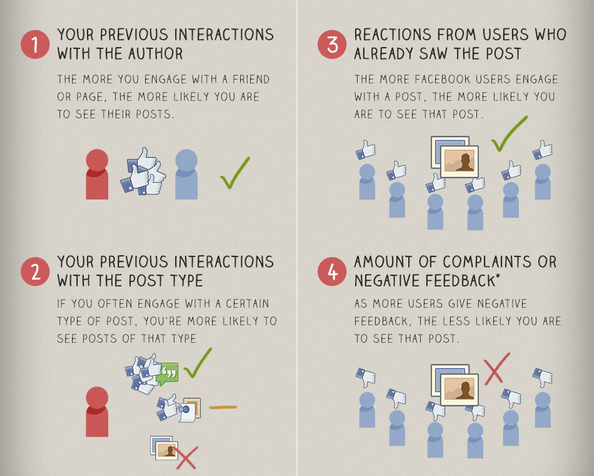
While not the only factors in the news feed formula any more, these EdgeRank areas do still hold value, and you can strategize a little by optimizing in these places. There’s no cut-and-dry answer for how to get your content into a news feed, but at least this gives you a place to start.
A counterintuitive way to combat Facebook reach: Stop caring about it
Maybe we’re looking at Facebook reach all wrong.
That’s the theory posed by Jon Loomer who suggests that our pursuit of more reach is misguided.
Facebook reach might mean very little.
We could be chasing the wrong stats.
Not to be making excuses here, but it’s hard not to chase Facebook reach. The number gets top billing on Facebook’s analytics, and it appears on each and every update to a Facebook page telling us how many “people saw this post.”

Loomer’s point is that there are better indicators of success than reach, and these are the numbers we should be more concerned about.
Reach means very little because it is rarely a good indicator of success.
If you’re an advanced Facebook marketer (and I know you are!), you measure things like traffic to your website, leads and purchases that came as a result of your efforts on Facebook.
If you follow your metrics closely (and I know you do!), you know that a high Reach doesn’t guarantee these things.
He even goes so far as to be grateful for a page’s small reach. In essence, Facebook is showing your update to only those fans and followers who are most engaged with your brand and who are most likely to click, share, and interact with your content. Facebook is doing the efficient thing, sparing your content from those who wouldn’t care or click in the first place.
It’s an interesting idea and one that might make us all quite a bit saner when we’re checking our Facebook stats. As you can see below, if we were to base our Facebook performance on factors other than reach, the Buffer page would be quite a bit more rewarding to check.
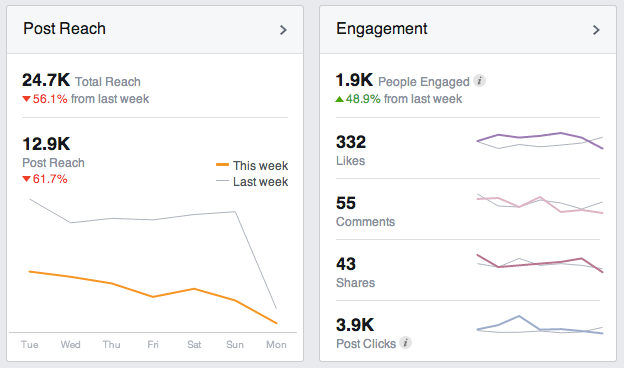
6 tips to expand your Facebook reach
Jay Baer, who connected the dots on Facebook’s declining reach and burgeoning bottom line, came up with a few solutions to fixing the problem of reach.
- Forget Facebook and go to Google+ and Twitter.
- Pay for advertising on Facebook.
- Get better at Facebook.
- Enlist others to do your Facebook marketing on their own profiles.
If you’re interested in Solution #3, then the ideas below should help you brainstorm some ways to grow your reach organically. (We’ve got tips for Google+ and Twitter, too, if you’d rather pack up shop and move on.)
1. Try the cultivation strategies used by Fortune 500 companies.
A research study published earlier this year in Public Relations Journal looked at how Fortune 500 companies and non-profits strategized to grow their brands on Facebook.
In particular, the study looked at six cultivation strategies:
Openness and disclosure – Showing what goes on inside the company
Access – Showing availability for customers and fans to reach and interact with the company
Positivity – Efforts to make a customer’s experience enjoyable and pleasant
Assurances – Making customers feel that their concerns are important and valid
Networking – Showing shared interests with followers and fans
Sharing of tasks – Collaboration with followers and fans to solve problems of mutual interest
The top three strategies used on Facebook were openness and disclosure, access, and positivity.
What might these strategies mean for you? Openness and disclosure could mean a shift toward more transparency on your Facebook page, sharing the inner workings of your company with your fans. Access could be as simple as sharing ways to that your customers can interact with you, and positivity could be part of your social media marketing voice.
2. Post at non-peak times.
There is a lot of research about the best time of day to post on Facebook. These studies make for a great jumping off point for experiments with your own sharing schedule. You can test and iterate from there.
Another interesting way to look at the question of “when to post” is to take the opposite advice from what most people tell you. Instead of posting when the majority of your audience is online, try posting when the majority of your audience is offline.
We’ve covered this effect before in our discussion of social media frequency, calling it the late night infomercial effect. Basically, it works on the assumption that when there’s little else being shared online, your content is more likely to stand out.
Again we’re grateful for Jon Loomer trying this theory out on his Facebook page. He compared the content he posted during peak hours (6:00 a.m. to 3:00 p.m.) with content that he posted during non-peak hours (10:00 p.m. and 3:00 a.m.). He even went so far as to break the posts down into types: photos, links, and updates.
In every case, the reach was greater for content posted on non-peak times.
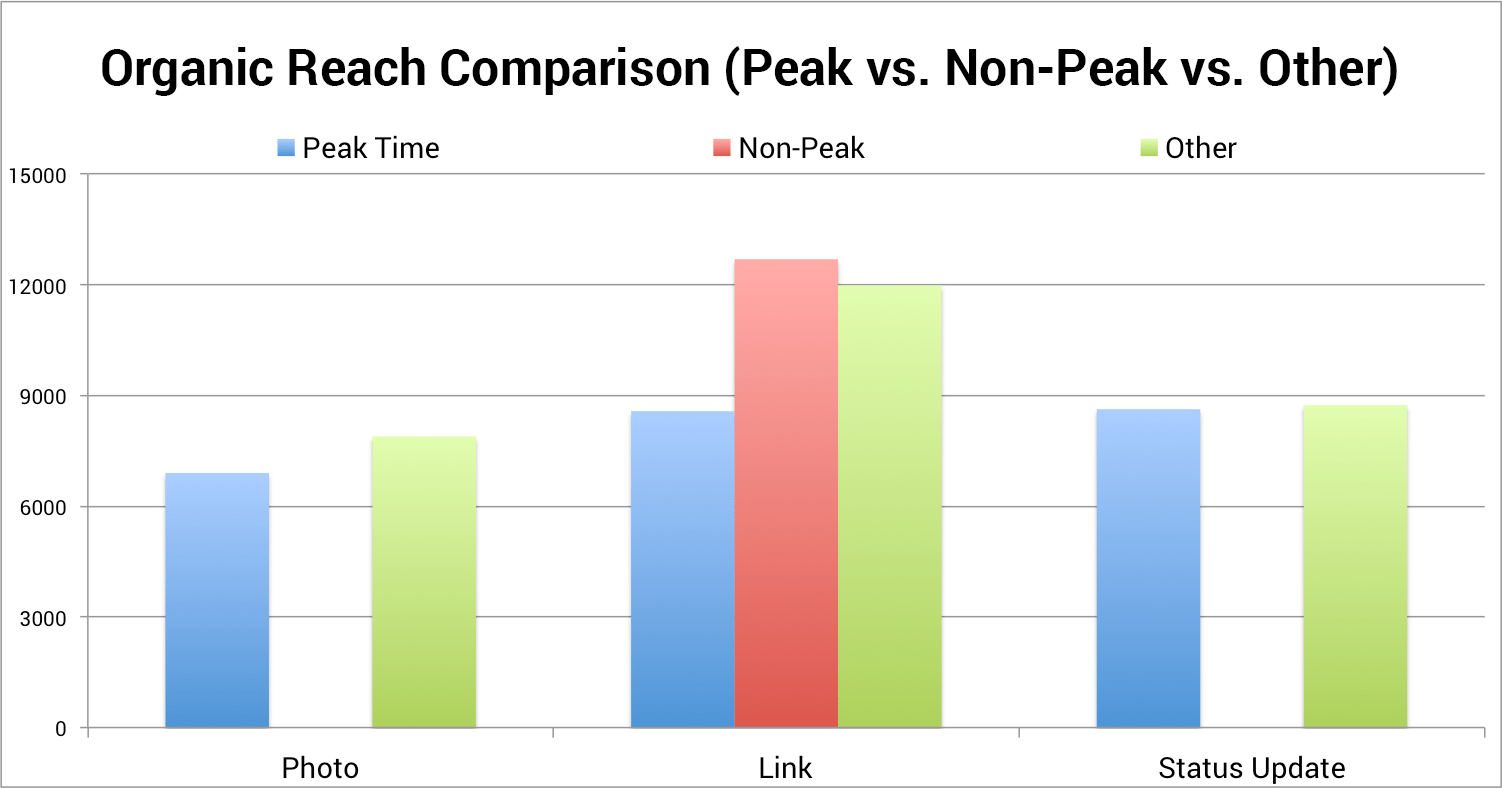
There are some interesting theories for why this is the case. First, this bump could be due to the late night infomercial effect where Loomer’s late-night content faced less competition from other updates and shares at these times. Another reason could be audience. If you enjoy an international following, then many of them could be online during your off-peak hours.
Interestingly, this content could also benefit from an extended stay at the top of the news feed because of all the attention it gets late at night. When the peak hours begin and users log on for the first time, the late-night content will have had time to gain popularity and could surpass many of the brand new posts that have yet to gain traction. Posting at night might mean starting at the top of the page in the morning.
So where do you find when your peak and non-peak hours are? Facebook Insights has a helpful chart that you can access by clicking on the Pages tab at the top of your analytics dashboard. Here is what our fan timeline looks like at Buffer:
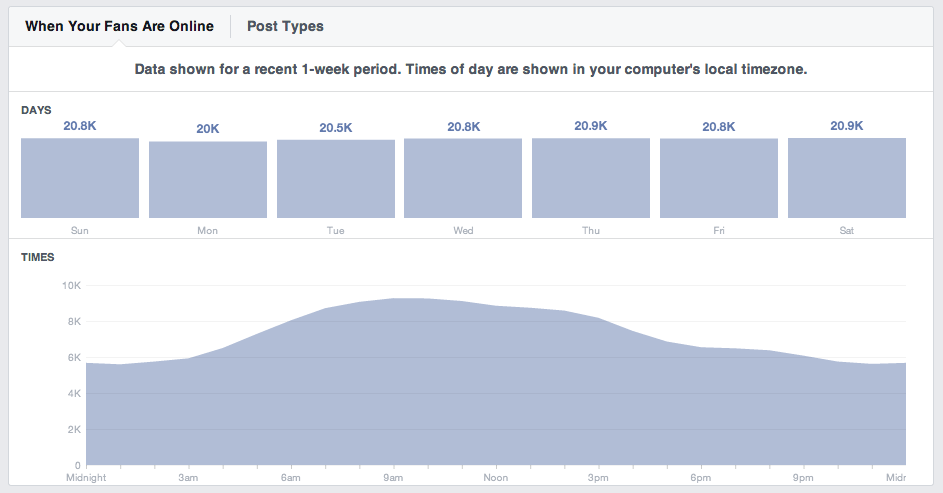
We may want to try the 11:00 p.m. to 1:00 a.m. window for ourselves.
3. Share original, behind-the-scenes photos of you and your team.
We had the fortune of going on a Buffer retreat to South Africa recently, around the same time we started experimenting with ways to grow our Facebook reach. Wouldn’t you know it that our retreat led to some pretty amazing opportunities to share original content on Facebook!
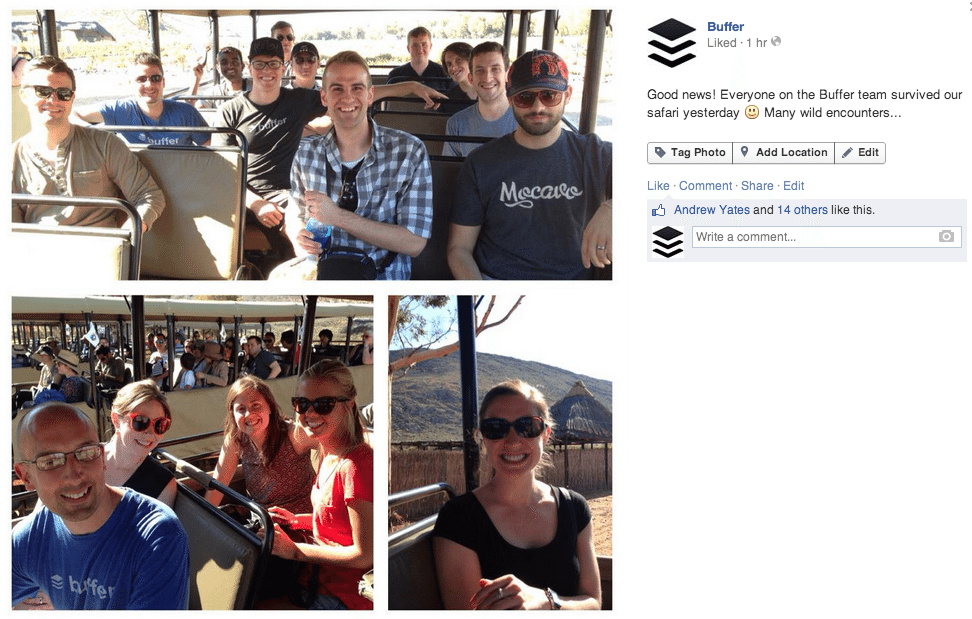
We shared safari pictures, workday videos, and much more from our retreat, and as you can see from the below numbers, these posts worked quite well. (The retreat posts are marked in orange.)
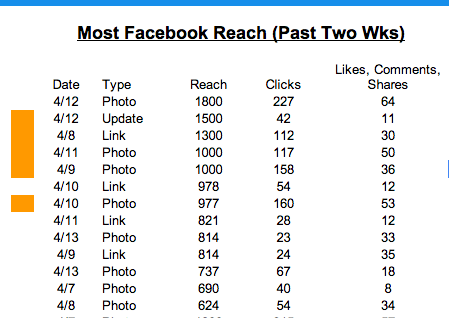
Of course, now everyone’s back home. How can we keep this up when we’re not in South Africa anymore? How can you make this work for your own business when you’re not coming and going from retreats all the time?
We’re anxious to find the answers for ourselves. The first place we might start is with sharing behind-the-scenes photos of the way we work at Buffer, along with a continued push on insider videos from our founders Joel and Leo. We’ll be sure to let you know how it goes.
4. Engage your community with questions.
Another strategy we’ve started employing is asking engaging questions as status updates. There are no links in these updates. No selling. No informing. We’re simply interested in hearing from our audience.

Here are the numbers on those tests.
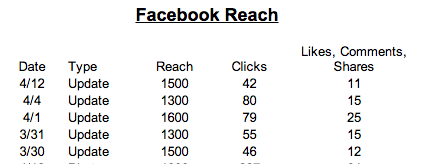
In every case, we received more than 1,000 people in our reach, which is an above average result from the rest of the Facebook content we post.
Like the behind-the-scenes retreat photos and videos, asking engaging questions gave us enough bump that it’s worth pursuing further to see if we can impact Facebook reach for all posts. If certain elements of the Facebook algorithm are to be believed, the engagement here could lead to the improvement of some of our news feed factors in the long run.
5. Share self-explanatory photos.
You have likely heard the advice to share photos on Facebook. But these aren’t just any photos.
We ran some tests awhile back and determined that it takes a very specific kind of photo to see results on Facebook shares. Our internal rule is this:
“Posting pictures to Facebook only works well if the pictures are self-explanatory.”
When posting pictures to Facebook, they should be detailed enough that a person can understand your content without reading any of the text you added to the update. Here are a pair of examples (one good, one less good) from our own Buffer account:
Example #1:

Example #2:

We obviously have not been immune to following the “post more pictures” advice blindly. Now that we know the value of a self-explanatory photo, we’re using it to create more high-quality image posts that will hopefully drive our engagement and our reach.
6. Look at the numbers differently.
The beauty of this tip is that it takes no marketing plan whatsoever to work (just some data extraction and finagling).
The key here is to look at reach from a different perspective.
Facebook makes it easy to see the reach of individual posts, and these are often the numbers that can bring you down and send you into crisis mode. Instead of focusing on reach from a granular level like individual posts, it makes more sense to take a step back and view your reach on a daily and weekly basis.
Jon Loomer tried this tactic with his Facebook page, and he noticed that instead of an individual post reach as low as 8.6 percent of his total fanbase, he reached 26.8 percent of his fans with daily organic reach.
Digging up this stat will take a bit of work. You’ll need to go to your Facebook page analytics and export data by clicking the button in the top right corner. The export button will open a popup where you can select what you want to download.
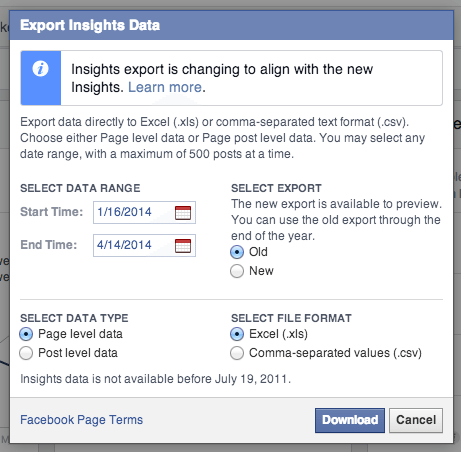
Under “Select Data Type,” be sure that “Page level data” is selected.
When you open the data file, you should see a column for Daily Organic Reach, and this can show you how well your page did from a slightly more positive vantage point.
Takeaways
What can we do about declining Facebook reach? We have options—paying for advertising, going some place else—and we have some organic tricks to try. If you decide that Facebook is worth it for your business (and with a userbase of over a billion people, your audience is likely there somewhere), then hopefully these tricks can help.
- Be transparent, helpful, and accessible.
- Share behind-the-scenes content.
- Engage your audience with questions.
- Share self-explanatory pictures and visual content.
And if all else fails, take some pressure off by not worrying about reach so much. There are other stats you can chase with just as much fervor.
What has been your experience with Facebook reach? Are there some tactics you’re trying to boost your numbers? I’d be interested to hear your experience and what you’re up to. Please do share in the comments.
P.S. If you liked this post, you might also like 9 Ways to Counteract Facebook’s Big Algorithm Change and 6 Recent Facebook Changes You Should Know About.
Image credits: Andrew Morrell Photography, Convince & Convert, PostRocket, Jon Loomer,
Try Buffer for free
140,000+ small businesses like yours use Buffer to build their brand on social media every month
Get started nowRelated Articles

This article looks into social media benchmarks for various industries and platforms.

This simple shortcut will help you cross-post and schedule posts to Bluesky with your iPhone.

What should I work on next? This is a thought that pops up many times throughout the day while I’m working as the Social Media Manager at Buffer. I’ll check Twitter/X, Instagram, LinkedIn, and Threads to make sure I’m covering all my bases and spending time in the best way possible. And on the good days, I’m right in the groove where I know exactly what to do next and what are the most important tasks that need to get done. What really helps me is making a checklist for my social media activi